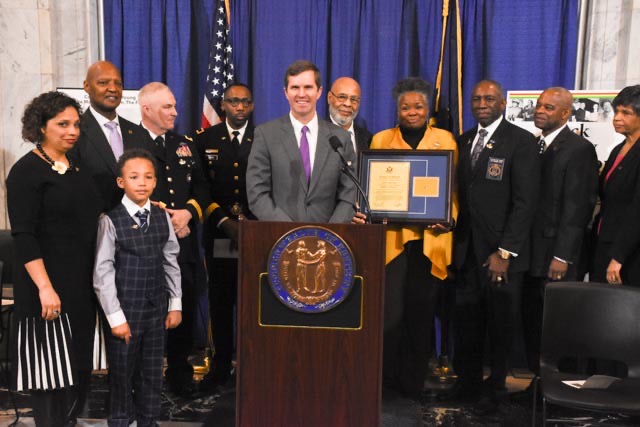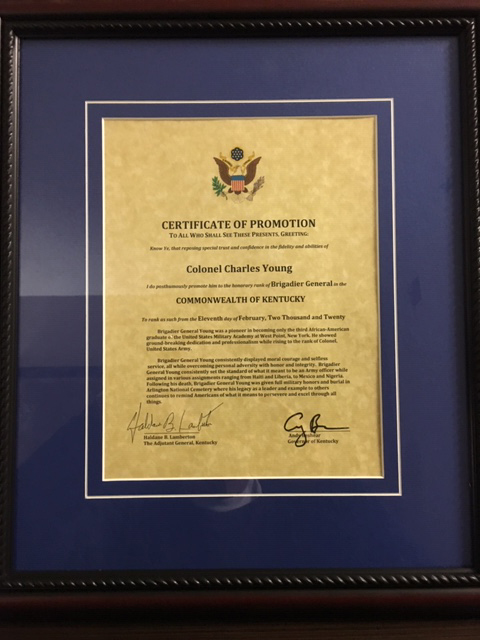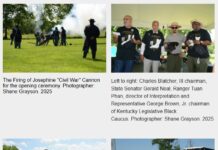
Joining me in receiving ceremonial Star from Governor Andy Beshear included the following: Lt. General William Ward, USA -Ret, Major General Reuben Jones, USA -Ret., Brigadier General Henry Huntley, USA – Ret., Brigadier General David Jenkins, USANG and Descendants of Colonel Young – Ms. Lyndsay Railey, and Ms. Denese Johnson.
In a ceremony held in the Frankfort State Capitol Rotunda, Kentucky Governor Andy Beshear made the legendary Charles Young an honorary Brigadier General in the Commonwealth of Kentucky. The ceremony was held as a part of the Kentucky Legislative Black Caucus History Month Celebration. The committee invited me as the keynote presenter of the program. Our Coalition had lobbied many years for historical redress for the legendary Soldier. We “Salute” the Governor for having the will to make it happen in the State of the Colonel birth. He presented a Citation marking the occasion that will go on display in the Kentucky Center African American Heritage. The Coalition presented the Stars for the ceremony. The Stars were contributed by two men who are also a part of American Military history: Lieutenant General Arthur J. Gregg, USA, Retired, the first Black Lieutenant General in Army History; Lieutenant General William E, Ward, USA Retired, inaugural commanding officer of the US African Command.
In attendance with Governor Beshear, was Constitutional officers, the Chief Justice and the entire court, Senate President, Minority Floor Leader, members of the Young Family, Retired General Officers and Veterans Organization Representatives. The ceremony was a public event.
Joining me in receiving ceremonial Star from Governor Andy Beshear included the following: Lt. General William Ward, USA -Ret, Major General Reuben Jones, USA -Ret., Brigadier General Henry Huntley, USA – Ret., Brigadier General David Jenkins, USANG and Descendants of Colonel Young – Ms. Lyndsay Railey, and Ms. Denese Johnson.
In a ceremony held in the Frankfort State Capitol Rotunda, Kentucky Governor Andy Beshear made the legendary Charles Young an honorary Brigadier General in the Commonwealth of Kentucky. The ceremony was held as a part of the Kentucky Legislative Black Caucus History Month Celebration. The committee invited me as the keynote presenter of the program. Our Coalition had lobbied many years for historical redress for the legendary Soldier. We “Salute” the Governor for having the will to make it happen in the State of the Colonel birth. He presented a Citation marking the occasion that will go on display in the Kentucky Center African American Heritage. The Coalition presented the Stars for the ceremony. The Stars were contributed by two men who are also a part of American Military history: Lieutenant General Arthur J. Gregg, USA, Retired, the first Black Lieutenant General in Army History; Lieutenant General William E, Ward, USA Retired, inaugural commanding officer of the US African Command.
In attendance with Governor Beshear, was Constitutional officers, the Chief Justice and the entire court, Senate President, Minority Floor Leader, members of the Young Family, Retired General Officers and Veterans Organization Representatives. The ceremony was a public event.

The following text is part of the presentation delivered in the keynote address: The topic was Black Military History and Colonel Charles Young.
Let me thank our host the Kentucky Black Legislative Caucus for the invitation that brings us here today. And, let me recognize our distinguish Governor Andy Beshear, Chief Justice John Minton, Senate President Robert Stivers, Speaker of the House James Osborne, Senate Minority Floor Leader Morgan McGarvey, House Minority Floor Leader Joni L. Jenkins, Constitutional Officers, members of the Young Family, General Officers and guest. I have been invited to speak about Black Military History and Colonel Charles Young.
The Black presence in the defense of this nation predate the Fall of Crispus Attucks, the Black Dock Worker who was among the first to fall in the incident known as the “Boston Massacre in 1770.” Prior to the Revolutionary War, Blacks served as Minute Men in the Colonies. Five thousand served in the Continental Army. I have heard it said that Blacks have participated in every war and conflict fought under the American Flag. It’s Not True. Our chain of service is broken. Following the War of 1812 Black enlistment was banned in the Armed Forces. The ban covered the period of the Seminole Indian War in 1835 to 1842. The subject of Black participation was controversial at the onset of the Civil War in 1861. The fear was of Black expectations of Civil Rights if allowed to participate. In 1862 the Union found itself suffering from a shortage of manpower. Secretary of War Edwin Stanton approved the enlistment of Black Soldiers. Fredrick Douglass, the Black Abolitionist and known by many as the Father of the Civil Rights Movement, seized the moment and called for Black volunteers to “Strike A Blow For Freedom.” Quoting Douglass, “…Once let a Black man get upon his person the brass letters U.S., let him get an eagle on his button and a musket on his shoulder and bullets in his pocket, and there is no power on earth which can deny that he has earned the right to citizenship in the United States.” End Quote. One hundred and eighty thousand Black Men volunteered for the Union Army.
President Lincoln was not receptive to the idea of Black participation in the beginning. However, in 1864 he argued for the continuous use of Black Soldiers. He explained his
conversion in the following quote … [“We cannot spare the hundred and forty thousand now serving as soldiers, seaman and laborers. This is not a question of sentiment or taste, but one of physical force which may be measured and estimated as horsepower and steam power are measured and estimated. Keep it and you can save the Union. Throw it away, and the Union goes with it.” End Quote. “Freedom comes with a price and the debt is never paid in full.” Black Soldiers made a substantial down payment, thirty-seven thousand died. At the war’s end, the number of Blacks allowed to remain in the Army was reduced. In 1866, the troops remaining were divided into the 9th & 10th Cavalries and the 24th& 25th Infantry Regiments. They became known as “The Buffalo Soldiers” the name given by our Native American Brothers and Sisters. The Buffalo Soldiers aided in the Western Expansion.
Following the Civil War during the period of Reconstruction there were Black Generals in State Militias. There was a total of nine who held the rank. Eight served in the South Carolina Militia between 1870 and 1873. One served in the Louisiana State Militia. One of the most noted is Robert Small, a Black Harbor Pilot who along with seven other slaves commandeered the Confederate ship “Planter” in the Harbor of Charleston. They surrendered the ship to the Union Forces. Robert Small served as a Major General in the South Carolina Militia in 1873. The United States Military Academy at West Point opened enlistment to Blacks in 1870. The first Black Cadet was James Webster Smith from South Carolina. Henry O. Flipper became the first Black Graduate in 1877, followed by John Alexander in 1887. And, Charles Young entered West Point in 1884. He is a significant figure in Black US Military History. You cannot study the subject without come upon his legacy. Para-phasing Dr. W.E.B. Dubois from his eulogy on Colonel Young in 1922.
“The life of Charles Young was a triumph of tragedy. No one ever knew the truth about the Hell he went through at West Point. He seldom even mentioned it. The pain was too great. Few knew what faced him always in his army life. It was not enough for him to do well-he must always do better; and so much and so conspicuously better, as to disarm the scoundrels that ever trailed him. He lived in the army surrounded by insult and intrigue and yet he set his teeth and kept his soul serene and triumphed.” End Quote
The following is a highlight of his Life and Military career.
- Native Son of Kentucky born to enslaved parents Gabriel and Arminta Young in Mays Lick, Kentucky on March 12, 1864.
- Lived his formative years in Ripley, Ohio
- Graduate of West Point in 1889 newly commissioned Second Lieutenant
- Young was initially assigned to the Ninth U.S. Cavalry and served at frontier posts Ft. Robinson, Nebraska and Ft. Duchesne, Utah from 1889-94
- Young served as Professor of Military Science at Wilberforce University in,
Ohio, from 1894-98; We accepted an Honorary Doctorate Degree from the University on his behalf in 2018. It’s on display at the Kentucky Center for African American Heritage in Louisville.
- In 1898 during the Spanish-American War, Young was appointed Major, U.S. Volunteers, in the Ohio National Guard to command its Ninth Infantry Battalion, but his unit was not sent overseas.
- In 1899 he returned to the Ninth Cavalry with his Regular Army rank of First Lieutenant, and served again at Ft. Duchesne, Utah.
- Promoted to Captain in 1901, Young commanded troops of the Ninth Cavalry in combat in the Philippine Insurrection from 1901-02.
- While serving in San Francisco, Young was temporarily posted as Superintendent of Sequoia National Park in 1903, the first Black American appointed as a National Park Superintendent.
- He was the first Black Officer appointed to duty as a military attaché serving in (Haiti and Dominican Republic) 1904 -1907.
- Young returned to the Ninth Cavalry and served at Camp McGrath in the Philippine Islands and Ft. D.A. Russell, Wyoming from 1908-11.
- Young served as military attaché to Liberia from 1912-15, where he was promoted to Major, developed the Liberian Frontier Forces, built roads, and was wounded during a rescue mission.
- In 1912, he was elected as an Honorary Member of the Omega Psi Phi Fraternity. I would like to acknowledge the members here today. They have been real Soldiers in carrying the Colonel’s legacy forward.
- For his exceptional work in Liberia, the NAACP awarded Young the Spingarn Award in 1916.
- Young was reassigned to the Tenth U.S. Cavalry and served in the Punitive –Expedition in Mexico with General Pershing from 1916-17, where he was promoted to Lieutenant Colonel.
- During his promotion board in 1917, Young was promoted to full Colonel and was unexpectedly medically retired from the Army. To prove his fitness for active duty, Colonel Young rode on horseback (and walked) nearly 500 miles from Wilberforce, Ohio to Washington, D.C. We hope to one day erect a statue of the Colonel in our Nation’s Capital to commemorate that historic ride while honoring the Black Soldiers of the Era. Let me share a little News with you. We plan to request the statue be put in front of the National Museum of African American History and Culture. A fitting location. The institution is dedicated to Civil Rights. Black Military History is the historical cornerstone of the Civil Rights Movements.
- The Colonel was recalled to active duty just days before the War ended on November 11, 1918. He was assigned to Camp Grant in Rockford, Illinois.
- In 1919 he again became military attaché to Liberia;
On an intelligence mission in 1922, he became critically ill and died. He was buried in Lagos, Nigeria on January 9th , 1922. He was buried with military honors rendered by British Soldiers. Upon the insistence of his wife Ada and members of the national community, his body was exhumed and returned to the United States. He was re-buried in Arlington National Cemetery on June 1st, 1923.
- His military career spanned 33 years. He was the highest-ranking Black Officer in the United States Armed Forces from 1894 until his death in 1922.
- Many Americans past and present felt had it not been for the political/social climateof the times. Colonel Young would have been the first Black Brigadier General in the regular United States Armed Forces. We agree! We called for a review of his Military Records a few decades ago. We were informed his Records, along with many other World War I era Veterans had been destroyed in the 1973 Fire at the Records Center
Charles Young’s promotion to Colonel is a benchmark in American and Black US Military History. It took 147 years from the Black Minutemen in the Colonial Days to the first Black Colonel in the US Armed Forces. In 1940, Benjamin O. Davis, Sr a protégé of Colonel Young became the first Black General in the Regular Armed Forces. It took 68 years from the First Black US General to the first Black Commander-in-chief with the election of Barack Obama in 2008. A tremendous amount of history lies between those years. (Stories to be told.) It’s American History, in the form of the first Black Paratroopers, the first Black Tank Battalions, the first Black Naval Officers, Black Coast Guard men, the first Black Marines, the first Black Airmen, the first Black women Nurses, and the first all-Black Women’s Battalion. The history documenting their Patriotism is undeniable. It’s history that should be taught in public education as a part of American History. It’s important because it’s a truer reflection of American History. It affirms our joint commitment, vested interest and collective responsibility in protecting the wellbeing of the principles of democracy. The history is the cornerstone of our earned Civil Rights. Today, we have one of the finest integrated Armed Forces in the World. And, it is the public’s responsibility to be vigilant in overseeing how they are used.
A few years ago, our Coalition sponsored a Bus Tour originating in Wilberforce, Ohio tracing the Colonel’s life through Ripley into Mays Licks. The tour guides were the late Doctor Jerry Gore (who is missed) and Doctor Floyd Thomas from the Ohio National Afro American Museum. It was a tour to be remembered. They brought the history of the Colonel and the Region to life.
We unofficially call the highway the Colonel Charles Young Corridor. We would like to see the highway officially designated honoring “The Native Son,” running from Mays Lick to the Ohio Border. We plan to ask the State of Ohio to pick-up the designation from the border through Ripley to the National Afro American Museum in Wilberforce. The designation would be great in promoting educational tourism to the Region. The inclusion of the Colonel Charles Young Veterans Flag Memorial in Louisville and Camp Nelson National Monument in Nicholasville adds to the educational attraction of the State. We have been encouraging tourism to the region through our Coalition of Organizations.
Last and certainly not least, we are excited about working with Aukram Burton, the Executive Director of the Kentucky Center for African American Heritage in establishing the Kentucky Brigadier General Charles Young Media/Arts Center in Louisville. Charles Young was a Renaissance Man. Aside from being an outstanding Soldier, he was a poet, composer, musician and play write. He would be honored having a Media Wing named in his honor. We encourage you to learn more about the Man, the Mission and the Facts of this true American Patriot. We are sure you will agree that he deserves the STAR of recognition. On the behalf of the National Coalition of Black Veteran Organizations, a special thank-you to Governor Beshear and the Kentucky Black Legislative Caucus for this occasion.
In closing, when in Louisville, please stop by the Heritage Center and view the Colonel Charles Young bronze maquette and presentation. Thank You.
########
Contact information: cnmmmf@aol.com






